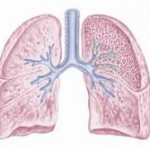 Patients
Patients
From November 2003 to March 2005, consecutive patients > 40 years of age who had been admitted to the emergency department of the University Hospital Basel (Basel, Switzerland) with an ECOPD and met post-bronchodilator therapy spiromet-ric criteria, according to the Global Initiative for Chronic Obstructive Lung Disease guidelines, within 48 h of emergency department admission were included in this study. An ECOPD was defined as “a sustained worsening of the patient’s condition, from the stable state and beyond normal day-to-day variations, that is acute in onset and necessitates a change in regular medication in a patient with underlying COPD.” Patients in whom there was found to be an alternative explanation for the presenting signs and symptoms other than a worsening of the underlying COPD were not included in the study. Patients who were considered to be vulnerable study participants (ie, those with psychiatric comorbidities) were excluded from the study. Other exclusion criteria were immunosuppression, asthma, cystic fibrosis, and the presence of infiltrates on chest radiographs on hospital admission.
Study Design
This single-center, randomized, controlled trial was approved by the institutional review board and was registered with the Current Controlled Trials Database. All participants gave written informed consent.
Baseline assessment included clinical data and routine blood tests. Procalcitonin levels were measured within 1 h after blood sampling using 20 to 50 μL of plasma or serum by a time-resolved amplified cryptate emission technology assay (Kryptor PCT; Brahms AG; Hennigsdorf, Germany). The assay has a functional assay sensitivity of 0.06 ^g/L, which is 3-fold to 10-fold above normal mean values.
Spontaneously expectorated sputum samples were obtained for Gram staining and culture. Bacterial isolation and identification was performed with the use of standard techniques described by the American Society for Microbiology.
Spirometry was performed by trained lung function technicians who were blinded to group assignment, according to American Thoracic Society guidelines. The patients’ functional status was assessed with the help of a visual analog scale, ranging from 0 (feeling extremely ill) to 100 (feeling completely healthy). Respiratory symptoms were quantified using a questionnaire for patients with respiratory illnesses (range, 0 to 95 [with higher scores indicating greater discomfort]).
Study Intervention
Patients satisfying the entry criteria were randomly assigned to one of two groups at the time of admission to the emergency department. In the standard-therapy group, antibiotic therapy was started based on current guidelines, according to the decision of the attending physician, who was unaware of the patient’s procalcitonin levels. In the procalcitonin group, antibiotic use was based on the measurement of procalcitonin levels at hospital admission. A procalcitonin level of 0.25 was considered to suggest the presence of bacterial infection, and antibiotic treatment was encouraged.
 Reevaluation of circulating procalcitonin levels and clinical status was recommended after 6 to 24 h if antibiotic therapy was withheld. Except for the prescription of antibiotics at the index exacerbation, the prescription of all other medications was left entirely to the discretion of the treating physicians throughout the study period in both groups.
Reevaluation of circulating procalcitonin levels and clinical status was recommended after 6 to 24 h if antibiotic therapy was withheld. Except for the prescription of antibiotics at the index exacerbation, the prescription of all other medications was left entirely to the discretion of the treating physicians throughout the study period in both groups.
Short-term and Long-term Follow-up
Patients were monitored daily until discharge from the hospital, and subsequent changes in clinical course and the prescription of new antibiotics were recorded. In all cases, the decision to initiate therapy with new antibiotics was left to the attending physician.
At the short-term follow-up visit (14 to 21 days), which was performed by a physician and a nurse on the study team, who were blinded to the group assignment, patients were evaluated based on clinical, laboratory, and lung functional criteria. Thereby, patients were classified into subgroups of “clinical success” (ie, improvement of symptoms compared to exacerbation status), and “clinical failure” (ie, the absence of the attenuation of symptom, the worsening of symptoms, or death).
The long-term follow-up visit (at 6 months), which was performed by a physician and a nurse on the study team, who were blinded to the group assignment, comprised a clinical, laboratory, and lung function assessment. Patients and family physicians were asked about the extent and the timing of health-care utilization due to exacerbations of COPD.
Outcome Measures
The primary end points of the study were total antibiotic use at the index exacerbation and up to 6 months, expressed as a percentage and relative risk (RR) of antibiotic exposure. Secondary end points included measures of clinical outcomes (eg, success, self-reported functional status, symptom scores, steroid dose, length of stay, need for ICU, or death), laboratory outcomes (eg, C-reactive protein and procalcitonin levels), and lung function outcomes on hospital admission, and at the short-term and long-term follow-ups. At 6 months, the exacerbation rate and time to the next ECOPD were assessed.
Statistical Analysis
Analyses were performed on an intention-to-treat basis by x2 test, two-sampled t test, or Mann-Whitney U test. RR was calculated with 95% confidence intervals (CIs). All tests were two-tailed; p < 0.05 was defined as being significant.
The time to the occurrence of clinical events was analyzed by Kaplan-Meier survival curves and by the log-rank test. To describe the changes in parameters up to 6 months, a repeated-measures analysis of variance was performed.
The trial was designed to demonstrate the persistent superiority of procalcitonin guidance in decreasing antibiotic use up to 6 months after the index exacerbation. The sample size was calculated from the following assumptions: a 75% use of antibiotics to treat the index exacerbation; and an expected absolute reduction of this frequency from 75 to 45% with procalcitonin guidance. Considering an exacerbation rate of 70% within 6 months, and 75% antibiotic use in the following exacerbations, a sample size of 186 patients (93 patients per group) was necessary to detect a significant difference in antibiotic use between both groups with a power of 85% and an a error of 0.05. Considering a 20% dropout rate after assignment to the study, 223 inclusions were planned. Analyses were performed using a statistical software package (SPSS, version 13; SPSS Inc; Chicago IL).


















